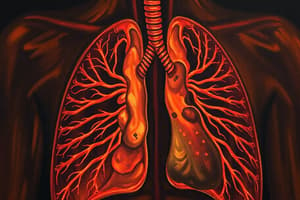Podcast
Questions and Answers
What primarily determines the diffusion rate of gases across the respiratory membrane?
What primarily determines the diffusion rate of gases across the respiratory membrane?
- The molecular weight of the gas
- Alveolar pressure alone
- The surface area of the respiratory membrane (correct)
- The solubility of the gas in plasma
Which statement about the thickness of the respiratory membrane is true?
Which statement about the thickness of the respiratory membrane is true?
- Increased thickness enhances diffusion.
- A thicker membrane decreases diffusion resistance.
- Increased thickness reduces the rate of gas diffusion. (correct)
- The average thickness is 1.2 μ.
How does molecular weight of a gas affect its diffusion rate across the respiratory membrane?
How does molecular weight of a gas affect its diffusion rate across the respiratory membrane?
- Heavier gases diffuse more rapidly.
- Lighter gases diffuse more rapidly. (correct)
- Molecular weight has no effect on diffusion.
- Lighter gases diffuse slower.
What is the diffusing capacity for O2 across the respiratory membrane at a pressure difference of 1 mm Hg?
What is the diffusing capacity for O2 across the respiratory membrane at a pressure difference of 1 mm Hg?
What effect does exercise have on the total surface area of the respiratory membrane?
What effect does exercise have on the total surface area of the respiratory membrane?
Which of the following factors does NOT enhance gas diffusion?
Which of the following factors does NOT enhance gas diffusion?
Which gas diffuses 20 times more rapidly than O2?
Which gas diffuses 20 times more rapidly than O2?
What effect does blood flow through the pulmonary capillaries have during exercise?
What effect does blood flow through the pulmonary capillaries have during exercise?
What factor contributes the most to the work of inspiration?
What factor contributes the most to the work of inspiration?
Which of the following statements is true regarding bronchial constriction?
Which of the following statements is true regarding bronchial constriction?
According to Poiseuille’s formula, what is the primary factor that affects airway resistance?
According to Poiseuille’s formula, what is the primary factor that affects airway resistance?
What is the role of intrapleural pressure during inspiration?
What is the role of intrapleural pressure during inspiration?
What characterizes Boyle's Law in relation to gas behavior?
What characterizes Boyle's Law in relation to gas behavior?
Which gas law can be used to explain the relationship between gas volume and temperature?
Which gas law can be used to explain the relationship between gas volume and temperature?
What is the primary reason for increased airway resistance during exercise?
What is the primary reason for increased airway resistance during exercise?
Which of the following correctly identifies a component of the respiratory membrane?
Which of the following correctly identifies a component of the respiratory membrane?
How does the presence of water vapor in air affect partial pressures?
How does the presence of water vapor in air affect partial pressures?
During a cough reflex, which action occurs last?
During a cough reflex, which action occurs last?
Flashcards
Compliance work
Compliance work
The force required to expand the lungs against the elastic forces of the lung and chest wall tissues.
Tissue resistance work
Tissue resistance work
The effort needed to overcome the viscosity of the lung and chest wall structures.
Airway resistance work
Airway resistance work
The work needed to overcome the resistance of the airways.
Bronchoconstriction
Bronchoconstriction
Signup and view all the flashcards
Bronchodilation
Bronchodilation
Signup and view all the flashcards
Cough reflex
Cough reflex
Signup and view all the flashcards
Poiseuille's Law
Poiseuille's Law
Signup and view all the flashcards
Intrapleural pressure
Intrapleural pressure
Signup and view all the flashcards
Charles' Law
Charles' Law
Signup and view all the flashcards
Boyle's Law
Boyle's Law
Signup and view all the flashcards
Respiratory Membrane
Respiratory Membrane
Signup and view all the flashcards
Diffusing Capacity
Diffusing Capacity
Signup and view all the flashcards
Diffusion
Diffusion
Signup and view all the flashcards
Factors Affecting Diffusion
Factors Affecting Diffusion
Signup and view all the flashcards
Changes in O2 Diffusion During Exercise
Changes in O2 Diffusion During Exercise
Signup and view all the flashcards
Surfactant
Surfactant
Signup and view all the flashcards
Alveolar Wall
Alveolar Wall
Signup and view all the flashcards
Interstitial Space
Interstitial Space
Signup and view all the flashcards
Study Notes
Respiratory System Lecture Notes
- Learning Outcomes:
- Describe factors affecting airflow resistance
- Describe factors affecting work of breathing, focusing on lower airway resistance
- Outline gas laws related to pulmonary diffusion
- Describe factors affecting net gas diffusion across the membrane
- Describe factors affecting pulmonary gas diffusion and their clinical significance
- Describe pulmonary oxygen diffusion capacity at rest and during exercise
Work of Breathing
-
Pressures: Pleural and alveolar
-
Resistance: Airways
-
Compliance: Ability to expand
-
Surface Tension: Surfactant
-
Components of Resistance:
- Alveolar surface tension
- Elastic resistance
- Airway resistance
Work of Inspiration
- Performed by respiratory muscles to stretch elastic tissues of the chest wall and lungs
- Compliance (65%):
- Work to expand lungs against lung and chest elastic forces
- Elastin and collagen fibers
- Surface tension
- Tissue resistance (7%):
- Work to overcome the viscosity of lung and chest wall structures
- Airway resistance (28%):
- Work to overcome airway resistance
- Increases during bronchiole constriction
Factors Affecting Airflow Resistance
- Parasympathetic:
- Constriction of bronchioles
- Mild to moderate constriction
- Vagus nerves release acetylcholine
- Action through M1, M2, and M3 receptors
- Increased intracellular Ca2+ and smooth muscle contraction
- Sympathetic:
- Dilation of bronchioles
- Norepinephrine and epinephrine
- Relatively weak direct control
- Release from adrenal medulla
- Stimulation of beta-adrenergic receptors leads to bronchodilation
Cough Reflex
- Receptors in airways stimulated by irritants
- Activation of vagovagal reflex
- Bronchoconstriction
- Rapid inspiration
- Epiglottis and vocal cords close tightly
- Abdominal muscles contract forcefully
- Expiratory muscles contract forcefully
- Pulmonary pressure rises rapidly
- Vocal cords and epiglottis open widely to expel air
Airway Resistance: Effect of Airway Radius
- Resistance determined by Poiseuille's formula: R = 8VL/πr4
- R = peripheral resistance
- V = viscosity
- L = length of tube
- r = radius of tube
- Viscosity and length do not change under normal conditions
- Diameter of airways is the major factor
- Minor radius change greatly affects airway resistance
Airway Resistance
- Intrapleural Pressure:
- Negative pressure keeps airways open during inspiration, decreasing resistance
- Positive pressure during forced expiration collapses some small airways, increasing resistance
- Excessive mucus increases resistance
- Exercise increases resistance
Gas Laws Applicable to Pulmonary Diffusion
- Charles' Law: Volume of gas is directly proportional to temperature (at constant pressure)
- Boyle's Law: Pressure of gas is inversely proportional to volume (at constant temperature)
Partial Pressures of Gases
- Total pressure: Sum of all component gases in a mixture
- Dry air: 21% O2, 78% N2, 0.04% CO2, and 0.096% other inert constituents
- Barometric pressure: 760 mm Hg at sea level
- Water vapor: Reduces partial pressures; 47 mm Hg inside the body
- Alveolar partial pressures: PO2 = 149 mm Hg, PN2 = 564 mm Hg, and PCO2 = 0.3 mm Hg
Respiratory Membrane
- Total surface area: 70 square meters
- Components:
- Alveolar epithelium
- Capillary endothelium
- Thin fluid layer with surfactant
- Alveolar wall
- Interstitial space
- Basement membranes of alveoli and capillaries
- Capillary endothelium
- Average thickness: 0.6 μm
Factors Affecting Diffusion: Diffusion Coefficient
- Diffusion depends on Fick's Law: Da (P1-P2) x A x S / d x Mol wt
- Da = diffusion coefficient
- P1-P2 = pressure gradient
- A = total surface area
- S = solubility
- d = thickness of membrane
- Mol wt = molecular weight of the gas
- Factors affecting diffusion:
- Pressure gradient
- Total surface area
- Thickness of the membrane
- Solubility of the gas
- Molecular weight of the gas
Factors Affecting Diffusion: Diffusion Coefficient
- Pressure gradient: Larger gradient, faster diffusion
- Solubility: Higher solubility, faster diffusion
- Molecular weight: Lower molecular weight, faster diffusion
- Surface area: Larger surface area, faster diffusion
- Thickness: Thicker membrane, slower diffusion
Diffusing Capacity
- Definition: Volume of gas that diffuses across the respiratory membrane per minute with a 1 mm Hg pressure difference
- O2 diffusing capacity: 23 ml/min/mm Hg
- CO2 diffusing capacity: 20 times faster than O2
Changes in O2 Diffusion During Exercise
- Increased blood flow through pulmonary capillaries
- More time for PO2 to reach equilibrium
- Increased surface area of respiratory membrane
- Increased ventilation and blood flow stretch alveolar and capillary walls
- Further enhancement from dormant capillaries opening
Studying That Suits You
Use AI to generate personalized quizzes and flashcards to suit your learning preferences.



